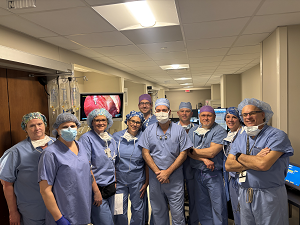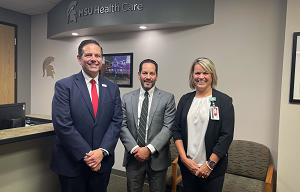Making the Case for Adjusting Quality Measures for Social Risk Factors

DETROIT (April 5, 2021) – A new analysis by a team of researchers led by Dr. David Nerenz of Henry Ford Health System suggests that accounting for social risk factors like poverty, housing instability and transportation insecurity can have meaningful impact on healthcare quality measures without compromising quality of care.
In a report published today in Health Affairs, researchers make the case for using social risk factors in specific circumstances to “level the playing field” for adjusting quality measures used in quality reporting and value-based purchasing programs. Social risk adjustment would apply to scenarios in which providers cannot mitigate the impact of social risk factors and when those risk factors directly impact care outcomes.
 “We acknowledge the challenges in knowing when social risk adjustment is appropriate, but we have shown when it should be done and not done,” said David Nerenz, Ph.D., Director Emeritus of Henry Ford’s Center for Policy and Health Services Research and the study’s lead author.
“We acknowledge the challenges in knowing when social risk adjustment is appropriate, but we have shown when it should be done and not done,” said David Nerenz, Ph.D., Director Emeritus of Henry Ford’s Center for Policy and Health Services Research and the study’s lead author.
“In our analysis we show that adjusting for social risk factors will not necessarily mask or excuse poor quality. Instead, it can demonstrate exceptional levels of quality among safety-net providers.”
Adjusting quality measures for social risk factors has been the focus of ongoing debate for the last decade since the Medicare Hospital Readmission Reduction Program (HRRP) was shown to disproportionately penalize safety-net hospitals financially. Safety net hospitals have long held they are unfairly penalized because social risk factors put their patients at higher risk for readmission and are not adjusted for in HRRP.
In 2014, an expert panel convened by the National Quality Forum recommended using social risk factors under certain circumstances. However, the Assistant Secretary of Planning and Evaluation, the principal advisor to the secretary of the U.S. Department of Health and Human Services, issued a report in June 2020 opposing adjustments for social risk factors.
“This has been a contentious issue, but there is growing consensus that social risk matters,” said Karen Joynt Maddox, M.D., MPH, a co-author of the Health Affairs report and Assistant Professor of Medicine in the Cardiovascular Division at Washington University’s School of Medicine in Missouri.
“To move towards high-value care that improves the health of populations, equity has to be central rather than an afterthought. We this analysis moves the needle on making that happen.”
Dr. Nerenz and Dr. Maddox led a study published in Health Services Research in 2019 that found a risk adjustment model including social factors could reduce the financial penalty for at least half of all safety-net hospitals, which care for patients regardless of their insurance status or ability to pay. In some cases, the study said, the adjustment model could render them free from any penalty.
Conversely, more affluent hospitals – those that care for higher-income, better-educated patients – could see their penalty for readmission rates increase.
Quality measures like mortality rates, readmission rates, complication rates, and average functional improvement are used to compare doctors, hospitals, home health agencies, and health plans. These measures are then applied to determine financial rewards and penalties for providers that perform relatively well or poorly.
Because providers don’t treat the same mix of patients, and some patients are at higher or lower risk of poor outcome than others, some form of statistical adjustment is applied to level of the playing field for making comparisons, Dr. Nerenz said.
“While clinical risk factors like age, presence of other illnesses, and severity of illness are used routinely in these adjustments, social risk factors have not,” Dr. Nerenz said. “At issue is whether the financial penalties reflect true differences in quality of care, or they reflect factors other than quality that are outside of providers’ control.”
###
About Henry Ford Health System
Founded in 1915 by Henry Ford himself, Henry Ford Health System is a non-profit, integrated health system committed to improving people’s lives through excellence in the science and art of healthcare and healing. Henry Ford Health System includes Henry Ford Medical Group, with more than 1,900 physicians and researchers practicing in more than 50 specialties at locations throughout Southeast and Central Michigan. Acute care hospitals include Henry Ford Hospital in Detroit, MI and Henry Ford Allegiance Health in Jackson, MI – both Magnet® hospitals; Henry Ford Macomb Hospital; Henry Ford West Bloomfield Hospital; and Henry Ford Wyandotte Hospital.
The largest of these is Henry Ford Hospital in Detroit, a quaternary care research and teaching hospital and Level 1 Trauma Center recognized for clinical excellence in cardiology, cardiovascular surgery, neurology, neurosurgery, and multi-organ transplants. The health system also provides comprehensive, best-in-class care for cancer at the Brigitte Harris Cancer Pavilion, and orthopedics and sports medicine at the William Clay Ford Center for Athletic Medicine – both in Detroit.
As one of the nation’s leading academic medical centers, Henry Ford Health System annually trains more than 3,000 medical students, residents, and fellows in more than 50 accredited programs, and has trained nearly 40% of the state’s physicians. Our dedication to education and research is supported by nearly $100 million in annual grants from the National Institutes of Health and other public and private foundations.
Henry Ford’s not-for-profit health plan, Health Alliance Plan (HAP), provides health coverage for more than 540,000 people.
Henry Ford Health System employs more than 33,000 people, including more than 1,600 physicians, more than 6,600 nurses and 5,000 allied health professionals.
###
MEDIA CONTACTS: David Olejarz / David.Olejarz@hfhs.org / 313-303-0606
Diane Duke Williams / Williamsdia@wustl.edu / 314-286-0111
.svg?iar=0&hash=F6049510E33E4E6D8196C26CCC0A64A4)

/hfh-logo-main--white.svg?iar=0&hash=ED491CBFADFB7670FAE94559C98D7798)









